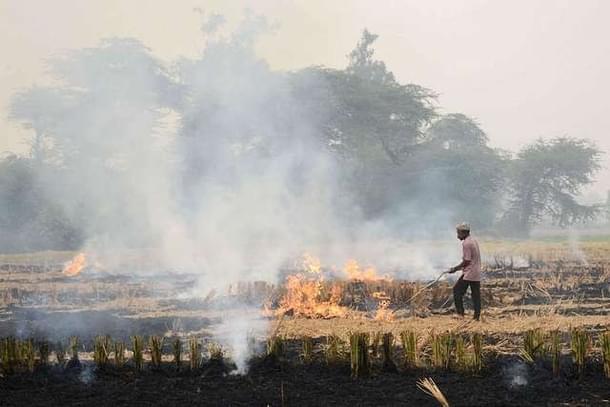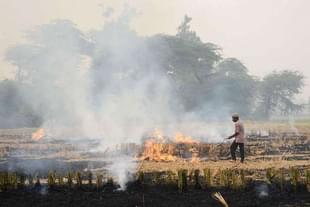Ideas
Stubble Burning: Kejriwal Will Continue To Play The Blame Game As Delhi Suffocates
Arjun Singh Kadian
Nov 01, 2018, 02:27 PM | Updated 02:27 PM IST
Save & read from anywhere!
Bookmark stories for easy access on any device or the Swarajya app.


In the last few weeks, like many other games he plays, the Delhi Chief Minister danced around the issue of air pollution in the capital. Since he assumed power in 2015, Chief Minister Arvind Kejriwal has developed a contagious disease of blaming everyone else for his failures. Purportedly working on the policy of ‘blame them, AAP’s gem’. On a serious note, this attitude of the Delhi Chief Minister has not only damaged his political ambitions by baring his non-serious attitudes towards governance but also caused irreparable damage to the environment. One can go as far as to say that M L Khattar-led Bharatiya Janata Party (BJP) government in Haryana has done more for Delhi’s environment than Kejriwal. Let me shed some light on it.
Around the fourth quarter of every year, wind patterns in the Indian subcontinent make a noticeable shift. The south-west monsoon starts to recede and withdraw from the north. This is accompanied by the jet streams from the Mediterranean Sea which enter India from the west. Thereby, a large envelope of wind streams converges on Delhi. This is a common pattern and has stayed almost the same for many centuries and for these many centuries, Haryana and Punjab have been agricultural states. Understandably, the debate on air pollution is a recent one. Why then is stubble burning made such an issue?
Punjab and Haryana are both agricultural states. Agriculture is also practised in the outskirts of Delhi in the Narela and other surrounding areas. Thanks to the Green Revolution, the states have prospered over time and large mechanisation of farmlands happened along with it. Tractors and harvesters have replaced traditional bull-drawn ploughs. These harvesters assist in quicker and easier threshing; higher yields and more income.
As the season changes, the farmers have to act quickly and prepare the land for the next crop. While this may seem easy with the machines in place, in all haste this exercise can’t finish the entire task. The harvesters that are used, trim the grain part of the crop and leave the stubble part on the ground. This stubble needs to be drawn out by hand or cut individually. Farmers have no incentive to preserve the stubble, so the time-tested exercise of burning the residue is put into action.
These burning residue particles find an ally in the converging winds and blow with full force towards Delhi. But those are not the only reasons for pollution in Delhi. A glimpse into Delhi’s air quality index will help in understanding that Delhi’s air in its hotspots is never really safe. A large number of cars, factories gushing polluting soot throughout the year etc, add to the pollution woes.
October brings big hustle in the region, the markets are full of shoppers and the business is at its peak. To keep it all running, motor vehicles move in and out of the city at both ‘odd and even’ hours. The last effort in making a policy initiative to fix Delhi’s environment was taken by the recently deceased former chief minister of Delhi Madan Lal Khurana, by launching the Delhi Metro. The current executive head plays the blame game.
Thanks to prominent infrastructure projects, now trucks heading from Ambala to Jaipur or as far as Mumbai can avoid Delhi altogether. The Haryana government in the last few months has also taken some concrete steps to fix the problem of stubble burning.
The National Green Tribunal and the Supreme Court put a ban on stubble burning; to enforce this, the Haryana government put in place stringent measures. In the last many months, campaigns to stop stubble burning have been organised. Officers across the state have worked tirelessly to sensitise the farmers on the harms of burning the straw; harms to the environment and losses to the productivity of the land. The state pollution control board started to fine farmers to discourage this practice. By June 2018, over 1,000 farmers had been fined with around Rs 12 lakh.
But, penalising the farmers is not a long-term solution. It can only be disruptive. Farmers across the state staged protests against fines. From Fatehabad to Ambala, farmers gathered to oppose the penalty imposed by the board. Yet, in order to prepare their lands for the next sowing season, agriculturists have to get rid of the stubbles.
From 2017 to 2018 in the month of September-October, Haryana has seen a reduction of about 33 per cent in the number of incidents of stubble burning. From 4,977 last year, the figure dropped to 3,430, statewide. For Delhi, in the same time frame, there has been about a 50 per cent increase in the number of incidents.
The Haryana government has now opened over 900 customer hiring centres (CHCs) across the state. From these centres, farmers can hire stubble management machines at a highly discounted price. There is a variety of choice of machines one could use and avoid the burning of paddy straw. The super straw management system (SMS) is believed to be the best. It chops the stubble into very small pieces and spreads over. Other options include the happy seeder, which would chop the stubble and also sow wheat seeds, the rotavator and mulcher are others. The CHCs have been fairly active and many farmers have adopted the practice in Haryana.
However, still, the first step to putting an end to stubble burning is to find a use for the stubble. The government has announced awards to people who can come up with viable solutions. To begin with, the stubbles can be used as fodder or even in bio-thermal power plants. Rice straw can be used for the production of bio-oil, paper and biogas. All these options are being explored.
What remains to be seen is how these efforts play out. Delhi is a dangerous city to visit in the next couple of days. The Delhi Chief Minister will continue the blame game, regardless of weather patterns and efforts by neighbouring states. But Delhi should not lose hope for in times of distress Dilliwalas have come together. A case in point would be the resistance to tree-cutting and efforts to plant trees across the city-state.





